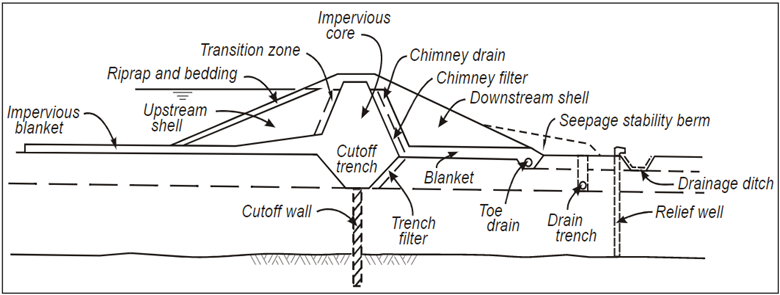Embankment Dams: Difference between revisions
No edit summary |
No edit summary |
||
| Line 47: | Line 47: | ||
==Trainings== | ==Trainings== | ||
{{Website Icon}} [[On-Demand Webinar: Introduction to Embankment Dams]] | |||
</br> | </br> | ||
Revision as of 21:47, 18 August 2022

|
| Cross section of a breached earthfill dam (Santa Clara) |
“Earthfill dams are the most common type of dam, principally because their construction involves the use of materials from required excavations and the use of locally available natural materials requiring a minimum of processing”.[1] Materials used for embankment dams include natural soil or rock, or waste materials obtained from mining or milling operations. An embankment dam is termed an “earthfill” or “rockfill” dam depending on whether it is comprised of compacted earth or mostly compacted or dumped rock. These types of dams are often constructed using layers of soil with varying levels of hydraulic conductivities in order to prevent excessive seepage through the embankment.
“Rockfill dams use rock of all sizes to provide stability and an impervious membrane to provide watertightness. The membrane may be an upstream facing of impervious soil, a concrete slab, asphaltic-concrete paving, steel plates, other impervious elements, or an interior thin core of impervious soil”. [1]
The ability of an embankment dam to resist the reservoir water pressure is primarily a result of the mass weight, type and strength of the materials from which the dam is made.
Components of Embankment Dams
Typical embankment dam design elements are illustrated in the figure on this topic page. The upstream and downstream slopes of embankment dams are typically 2H:1V (horizontal to vertical) or flatter. Their capacity for water retention is due to the low permeability of the entire mass (in the case of a homogeneous embankment) or a zone of low-permeability material (in the case of a zoned embankment dam).
Materials used to construct embankment dams include natural soil or rock obtained from onsite borrow areas or nearby quarries. If the natural material has a high permeability, then a zone of very low permeability or impervious material is normally included in the dam to provide resistance to flow and dissipate the hydrostatic pressure caused by the reservoir over a short distance. Some embankment dams use a masonry or concrete corewall to create the impervious barrier within the embankment. The ability of an embankment dam to resist the hydrostatic pressure caused by reservoir water is primarily the result of the mass or weight of the structure and the internal strength of the soil materials.
Many small dams and older dams consist of a homogeneous earth embankment where the dam is constructed of similar material throughout. Modern embankment dams are normally constructed with a zoned embankment and are composed of zones of selected materials having different degrees of porosity, permeability and density. Most modern zoned embankments include a chimney drain and toe drain to collect and filter seepage through the embankment and increase the stability and long-term performance of the structure. The chimney and toe drain consist of coarse-grained material (sand and gravel) which has little resistance to the flow of water and is not prone to shrinking or cracking. Seepage entering the drains flows freely through it and exits safely beyond the dam without saturating the material in the downstream zone. In general, embankment dams are designed to control seepage and prevent seepage from exiting the downstream slope.

|
| Typical embankment dam design elements in a zoned embankment. |
Life Cycle of Embankment Dams
Learn more about design, construction, operation, maintenance, or decommissioning of embankment dams here:
Examples
Best Practices Resources
![]() Design of Small Dams (United States Bureau of Reclamation, 1987)
Design of Small Dams (United States Bureau of Reclamation, 1987)
![]() Technical Release 210-60: Earth Dams and Reservoirs (Natural Resources Conservation Service, 2019)
Technical Release 210-60: Earth Dams and Reservoirs (Natural Resources Conservation Service, 2019)
Trainings
![]() On-Demand Webinar: Introduction to Embankment Dams
On-Demand Webinar: Introduction to Embankment Dams
Citations:
Revision ID: 2192
Revision Date: 08/18/2022
